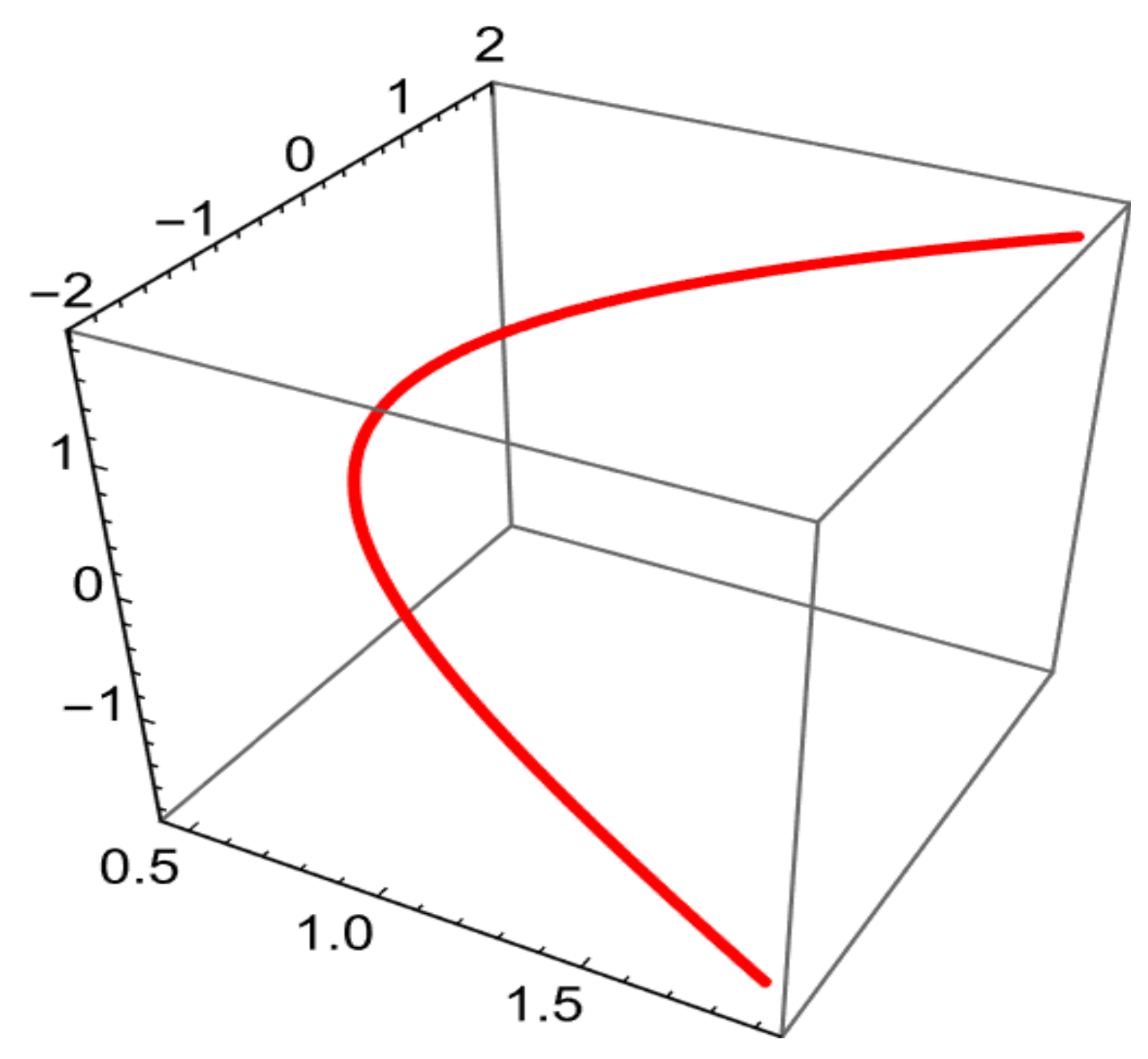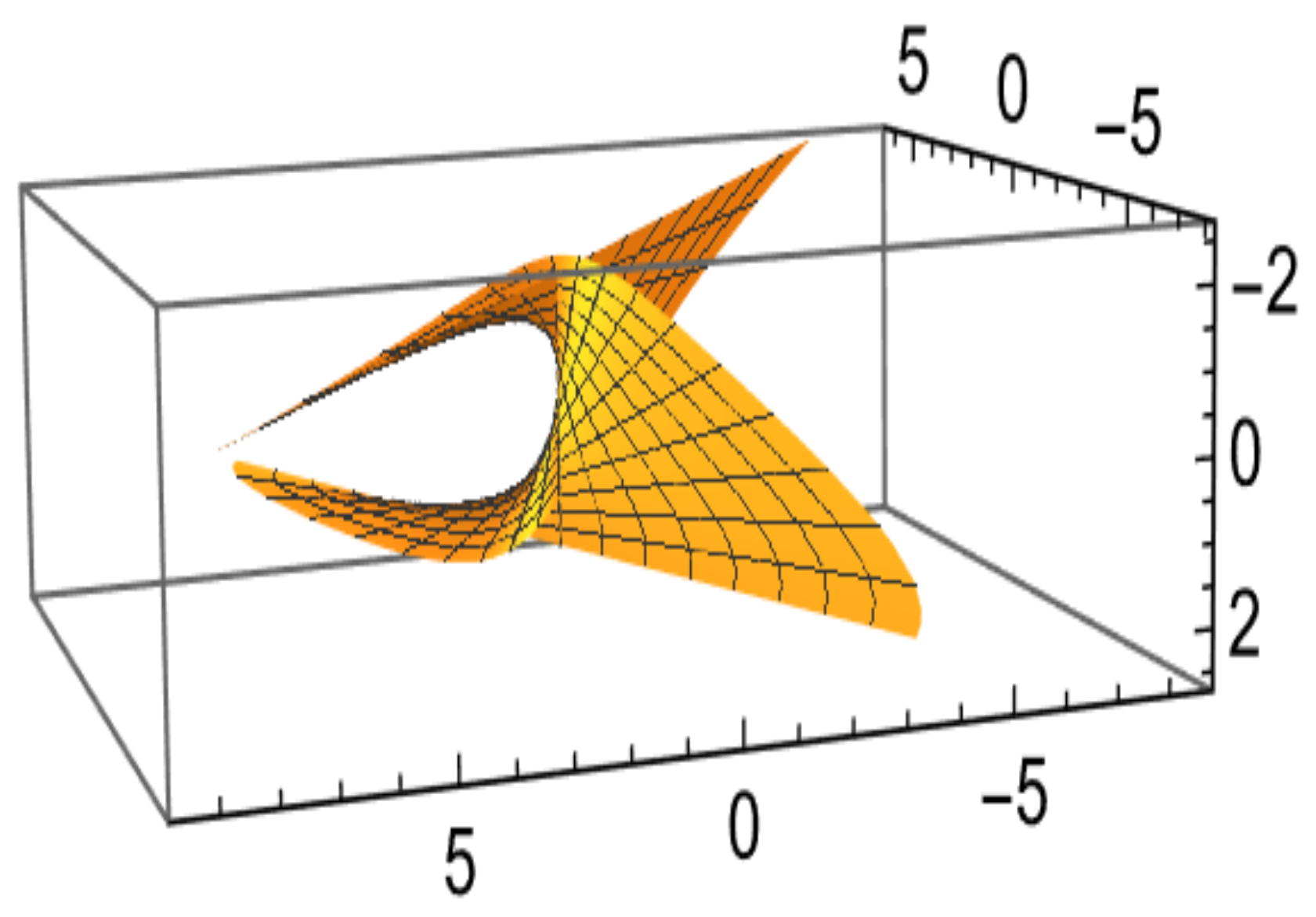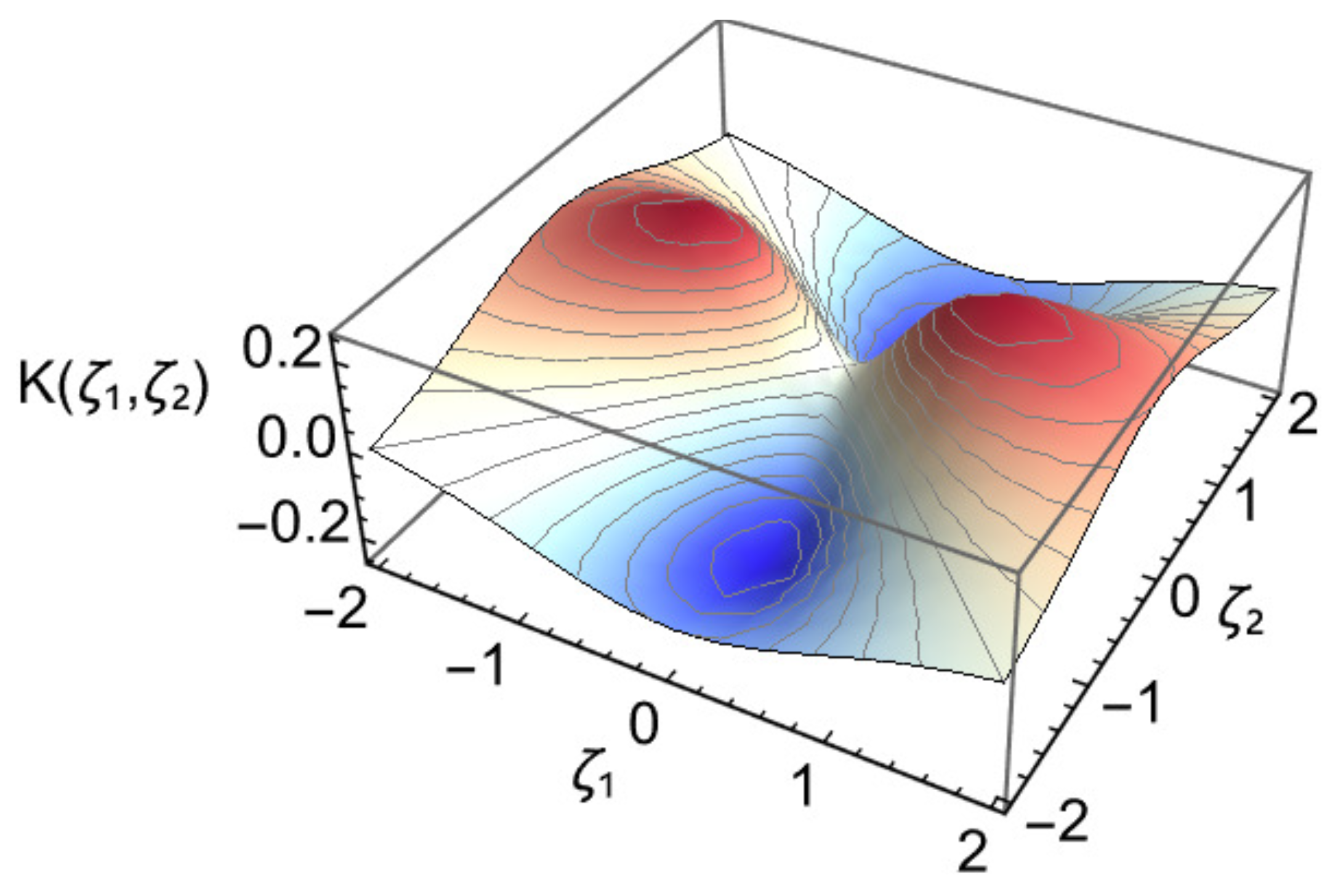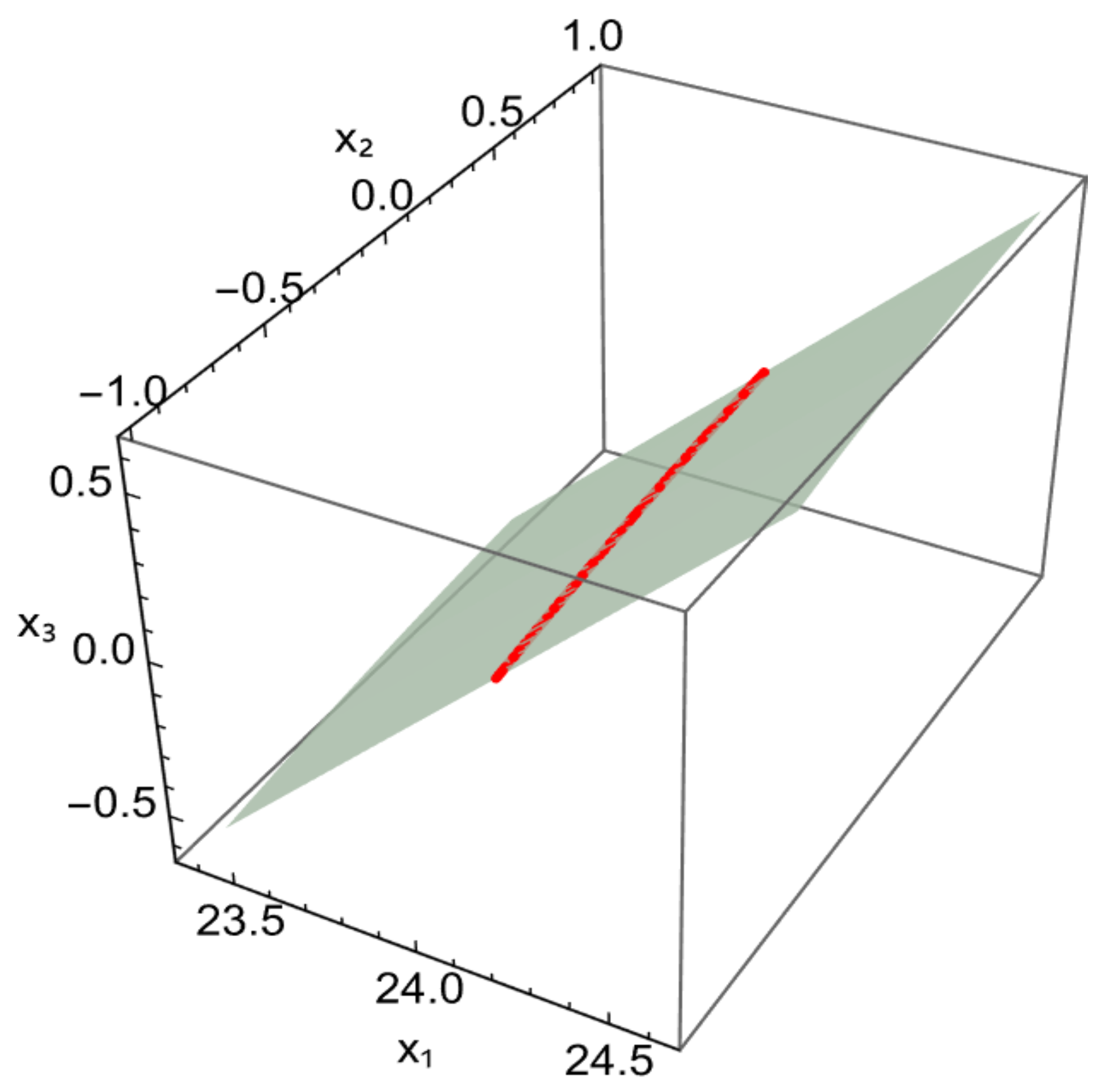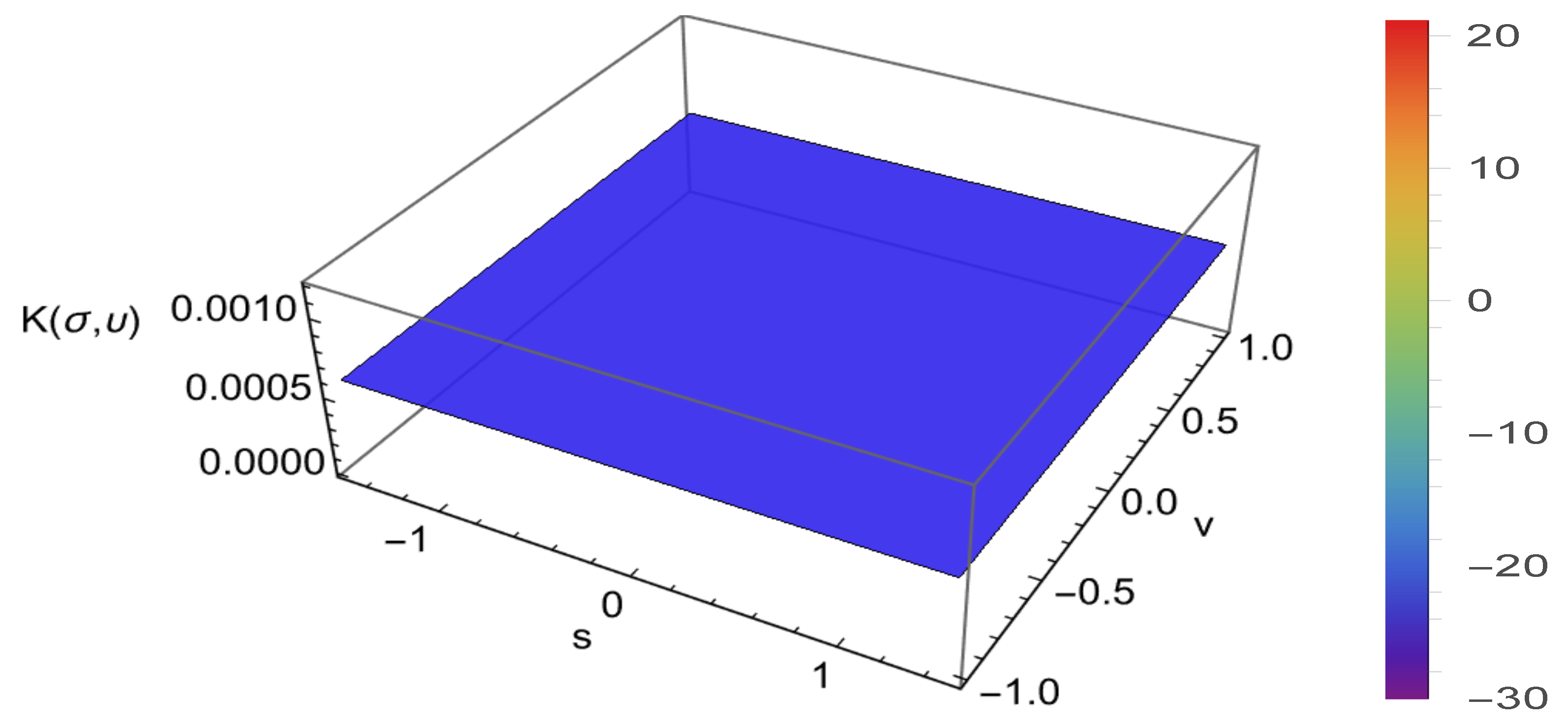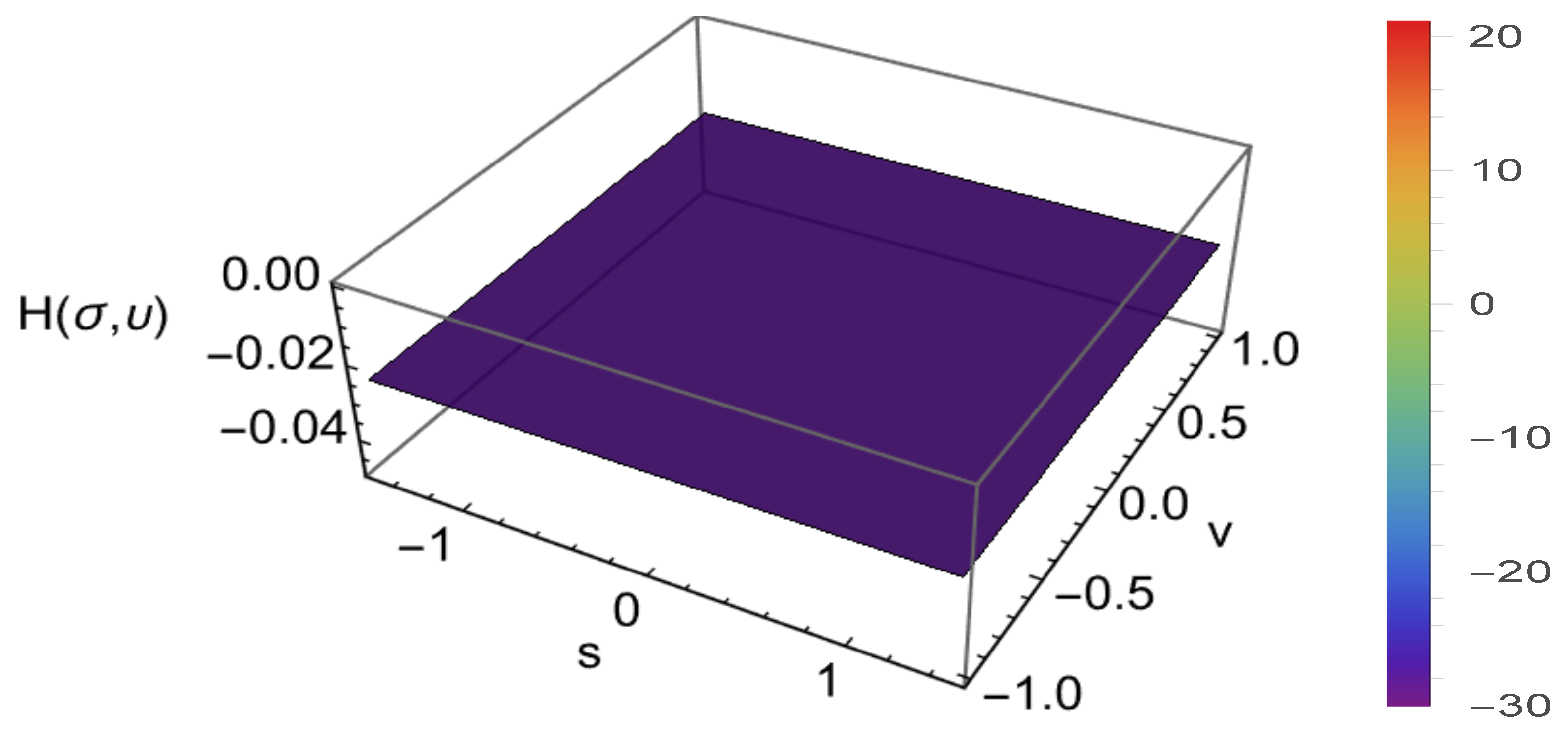1. Introduction
Ruled surfaces have long been a fundamental topic in differential geometry due to their analytical elegance and practical relevance in mechanics, architecture, and theoretical physics. A ruled surface is generated by the motion of a straight line (the ruling) along a base curve. In Euclidean geometry, their developability, minimality, and curvature properties have been extensively studied. In contrast, in Minkowski 3-space , which represents flat Lorentzian geometry, the causal nature of vectors and curves spacelike, timelike, or null produces more intricate geometric behavior without direct Euclidean analogues.
In physics, ruled surfaces in naturally describe relativistic models such as string world-sheets, lightlike hypersurfaces, and geodesic congruences. The Bishop frame, which remains smooth even when curvature vanishes, provides a stable alternative to the Frenet–Serret frame for such analyses. Studies of minimal and developable ruled surfaces in Lorentzian settings also contribute to the understanding of geometric structures underlying cosmic strings, wave propagation, and optical systems.
The Frenet–Serret frame, though classical, becomes undefined when curvature vanishes. To address this limitation, L. R. Bishop introduced in 1975 the Bishop frame or parallel transport frame, which replaces torsion by two independent curvature functions—the Bishop curvatures—offering greater flexibility in describing the rotation of the normal plane [
1]. Subsequent extensions of the Bishop frame to Lorentzian geometry were initiated by Ilarslan and Nesovic [
2] and further developed by Kalkan, Senyurt, Yüce, and others [
3,
4,
5].
A recent development is the concept of osculating type-2 ruled surfaces, where the ruling lies in the osculating plane of the base curve. Boyacioglu Kalkan and Senyurt [
6] examined these surfaces in Euclidean 3-space using the Type-2 Bishop frame, determining conditions for developability and minimality. Related studies in Minkowski 3-space by Kocayigit and Öztürk [
7], Kaya et al. [
8], Ali [
9], Karacan et al. [
10], and Özgür Boyaciŏglu Kalkan and Süleyman Şenyurt [
11] revealed the strong influence of Lorentzian metrics on surface curvature and causal classification.
The present work develops and analyzes osculating type-2 ruled surfaces defined via the Type-2 Bishop frame in Minkowski 3-space. The Lorentzian structure introduces hyperbolic transformations between the Frenet–Serret and Bishop frames, leading to new differential geometric relations. We derive conditions for cylindrical, developable, minimal, and flat surfaces, and determine when the base curve acts as a geodesic, asymptotic curve, or line of curvature. Finally, examples are provided to visualize the influence of the curvature parameters and .
2. Geometric Preliminaries of Curves and Surfaces in
In this section, we review the basic notions and notations used throughout the paper, including the geometry of Minkowski 3-space, the Frenet and Bishop frames of a spacelike curve, the Type-2 Bishop frame, the fundamental forms of a surface, and the curvature formulas relevant to ruled surface geometry.
The Minkowski 3-space
is the real vector space
endowed with the Lorentzian metric
for all vectors
and
in
. This metric has signature
and classifies nonzero vectors as:
spacelike if or ;
timelike if ;
lightlike (null) if and .
A curve
in
is called spacelike, timelike, or lightlike according to the causal character of its tangent vector
[
12,
13,
14].
Let
be a spacelike curve parameterized by arc length in
, with a timelike principal normal and a spacelike binormal. The Frenet frame
satisfies
and the Lorentzian Frenet Serret formulas are
where
and
denote the curvature and torsion, respectively [
15].
Since the Frenet frame becomes undefined when
, the Bishop frame (or parallel transport frame) offers a continuous alternative. For a spacelike curve
, the Bishop frame
satisfies [
6,
11]
where
and
are the Bishop curvatures.
For a spacelike curve with a timelike principal normal and spacelike binormal, the Type-2 Bishop frame
in
is defined by [
16]
where
and the hyperbolic angle
is given by
The relation between the Frenet and Type-2 Bishop frames is
Let
be a regular surface in
with tangent vectors
The first fundamental form is
where
The unit normal vector
n (spacelike or timelike depending on the surface type) is defined by
The second fundamental form is then given by
where
The intrinsic and extrinsic curvatures of
are described by the Gaussian curvature
K and mean curvature
H, respectively [
17,
18,
19,
20,
21]:
3. On the Geometry of Osculating Ruled Surfaces in Minkowski 3-Space
In this section, we develop the concept of osculating ruled surfaces defined through the Frenet frame in Minkowski 3-space . The construction relies on the geometric symmetry associated with osculating curves. We analyze the relationship between these surfaces and the curvature functions of their generating curves and examine several intrinsic geometric properties derived from the Frenet frame of .
Let
be a spacelike curve whose principal normal vector is timelike and whose binormal vector is spacelike, parameterized by its arc-length
. We define the osculating ruled surface whose rulings lie in the osculating plane
of the curve
by
where
denotes the Frenet frame described in Equations (
2) and (
3). For simplicity, we denote
and
. The partial derivatives of the parametrization are
Using the Minkowski inner product, the coefficients of the first fundamental form are computed as
The discriminant of the first fundamental form is then
The surface normal and second fundamental form coefficients are given by
where
The coefficients of the second fundamental form are
where
(The full expression for
is omitted for brevity.) The Gaussian and mean curvatures of the osculating ruled surface are obtained as
Theorem 1.
The osculating ruled surface in is developable if and only if Proof. A ruled surface is developable if and only if
,
ℓ, and
are linearly dependent for every
, i.e.,
. Expressing these vectors in the Frenet basis:
,
, and
, where
,
, and
, we obtain
Thus, the surface is developable if and only if
for all
, which gives the stated condition. □
Theorem 2. Let be an osculating ruled surface in . Then, for each fixed σ:
If , the surface has no singular points at that σ.
If and , then the base curve (corresponding to ) is the singular edge at that σ.
If and , then singularities appear whenprovided .
Proof. From (
13), the unit normal vector can be written as
where
and
.
If , the B-component at equals , ensuring . Hence, no singularity occurs.
If
, the
T and
N components vanish, and the
B-component reduces to
Thus,
which vanishes only at
, confirming that the base curve forms the singular edge.
If
and
, then
If the denominator vanishes, remains nonzero and no singularity appears.
This concludes the proof. □
4. Geometric Analysis of Osculating Type-2 Ruled Surfaces in Minkowski 3-Space
In this section, we establish the formulation of osculating type-2 ruled surfaces constructed via the type-2 Bishop frame. The construction relies on the geometric symmetry associated with osculating curves. These surfaces are investigated through the curvature functions of their generating base curve. Moreover, explicit analytical expressions are obtained for their Gaussian and mean curvatures, and several fundamental surface curves are examined in detail. It is observed that the differential geometric properties of such surfaces, described within the type-2 Bishop frame in , display structural resemblance to the rectifying ruled surfaces formulated using the Frenet frame. The results further demonstrate a close geometric link between osculating type-2 ruled surfaces based on the Bishop frame and rectifying ruled surfaces derived from the Frenet framework.
An osculating type-2 ruled surface generated by a curve
is defined by
where
and
are smooth scalar functions.
The partial derivatives of
are then given by
Using the vector cross product, we obtain
The squared norm of this vector is
Thus, the unit normal vector of
is expressed as
At
, it follows that
.
The first fundamental form coefficients are given by
The coefficients of the second fundamental form,
become
Hence, the Gaussian and mean curvatures of
are
Theorem 3.
Let be the osculating type-2 ruled surface in defined by (16). Then, the surface is regular at if and only ifOtherwise, the point is singular. Proof. Since the type-2 Bishop frame vectors
are orthonormal, the surface normal satisfies
Thus, the cross product vanishes only when
and
. Hence, condition (
23) ensures regularity. □
Theorem 4.
The osculating type-2 ruled surface in is developable if and only if Proof. Let the osculating type-2 ruled surface
be defined by
. By differentiating
with respect to
and applying Equation (
5), we obtain
Let us denote
. Then,
. To determine when the ruled surface
is developable, we use the classical criterion
Since
, and the frame
is orthonormal, we express the determinant in terms of this basis:
By expanding the determinant using the linearity property and the triple product formula
we compute
Using the standard right-handed relations in the Type-2 Bishop frame, we obtain
Now, since
and
T is orthogonal to
U and
V, we have
, and hence the determinant simplifies to
Since
and
, the only contribution arises from the direction corresponding to
B, giving
Therefore, the developability condition
, is satisfied if and only if
, i.e.,
. Therefore, the developability condition (
24) is satisfied. □
Proposition 1.
If and , then the singular set of the osculating type-2 ruled surface is the curve Proof. From
, we have
, which gives
. Substituting into
yields
which leads to the required formula for
. □
Corollary 1.
If , then and is constant. Hence, λ is constant, and the ruled surface degenerates into a plane. Consequently, there are no nontrivial cylindrical osculating type ruled surfaces.
Theorem 5. For the osculating type-2 ruled surface in defined by (16), the following hold: The base curve is a geodesic on .
The base curve is not asymptotic unless .
The base curve is a line of curvature if and only if .
Proof. For
, the unit normal (
19) reduces to
, and the acceleration of the base curve is
. Since
the geodesic curvature of the base curve vanishes; hence,
is a geodesic.
The normal curvature
satisfies
For the base curve (), we get . As , the condition implies , which contradicts the spacelike assumption. Thus, is not asymptotic unless .
A curve on is a line of curvature when and . For , we have , and , which reduces to .
□
Corollary 2.
If , the type-2 Bishop frame reduces to , and the surface becomes planar.
Remark 1.
It is worth noting that the Type-2 Bishop frame offers specific benefits when analyzing ruled surfaces in Minkowski 3-space. Unlike the standard Bishop frame, which is constructed for Euclidean spaces with a positive-definite metric, the Type-2 formulation incorporates a hyperbolic rotation that aligns naturally with the Lorentzian structure of . This adaptation makes the frame particularly effective for describing spacelike curves whose principal normal vector is timelike and whose binormal vector is spacelike. Because of this hyperbolic rotational behavior, the Type-2 Bishop frame maintains smoothness even when the curvature of the base curve vanishes and provides a more coherent representation of the causal and geometric properties of osculating type ruled surfaces in the Lorentzian context.
5. Examples
In this section we demonstrate the theoretical results through explicit examples of osculating type-2 ruled surfaces derived from various choices of base curves and type-2 Bishop frame data. These examples illustrate how the geometric features of the base curve affect the shape and curvature characteristics of the resulting surface. By modifying the parametrization of the generating curve and selecting different functional forms for and , we construct a variety of osculating type-2 ruled surfaces that reveal diverse and intricate geometric behaviors.
Example 1.
Choose the spacelike unit-speed curve (see Figure 1)The associated Frenet frame vectors together with the curvature κ and the torsion τ along are computed asThe type-2 Bishop frame and curvatures can be written asChoose and . Then the osculating ruled surface in given asAfter substituting the explicit expressions, this becomes (see Figure 2) The outcomes obtained in Example 1 are interpreted in relation to the theoretical framework presented in the preceding sections. By utilizing the computed Bishop curvatures and , we examined the condition for developability described in Theorem 1, where . The numerical evaluation indicates that this equality holds for specific parameter values, implying that the corresponding osculating type-2 ruled surface becomes developable in those regions. Additionally, the behavior of the base curve was analyzed to determine its geometric role on the surface. It was found that , confirming that the base curve satisfies the geodesic condition established in Theorem 5 These findings demonstrate a clear consistency between the theoretical predictions and the computed examples, showing how variations in and influence the developability and geodesic properties of the osculating type-2 ruled surface. Thus, this example effectively bridges the analytical results with their geometric interpretations.
Example 2.
Consider a spacelike curve φ parametrized by arc-length parametrized given byso that . We evaluate every quantity at the sample point (and parameter on the ruling). The numerical evaluation at givesUsing the Lorentzian inner product, we getThe hyperbolic angle satisfies . The Frenet-to-Bishop relations give at The Bishop ODE coefficients at areTake the osculating directorAt :Differentiate using type-2 Bishop ODE:, so
.HenceNumericallyThe osculating type-2 ruled surface is . Thus surface partials and unnormalized normal at (Figure 6). The unnormalized normal isUsing the Lorentzian inner product the squared norm isThe first fundamental form at are computed asNote — the chosen director direction is null (lightlike) at this point; nevertheless the surface is regular since . Now, using and . Then, we get HenceThe Gaussian and mean curvature at are computed as (Figure 7 and Figure 8) 6. Conclusions
This research has explored osculating-type ruled surfaces within Minkowski 3-space , formulated through the Type-2 Bishop frame of a spacelike base curve whose principal normal is timelike and binormal is spacelike. By employing the hyperbolic relationship that connects the Frenet–Serret frame with the Bishop frame, we established explicit formulas for the ruling directions and expressed the Bishop curvatures and in terms of the torsion and the hyperbolic rotation parameter . These formulations provide a consistent and smooth analytical approach for examining the geometry of ruled surfaces in Lorentzian space, thereby extending several well-known Euclidean results to the Minkowski framework.
Our findings indicate that the causal nature of the base curve and its associated frame vectors plays a crucial role in determining the geometric structure of the resulting surface. The hyperbolic transformation characteristic of the Type-2 Bishop frame replaces the ordinary circular rotation of Euclidean geometry with a Lorentzian boost, producing new relationships among the curvature quantities. This transformation influences the surface’s conditions for being developable, flat, or minimal, illustrating how torsion and hyperbolic rotation interact in shaping the local and global geometry of the surface.
The study also establishes how the Bishop curvatures control the geometry of the rulings, distinguishing between cylindrical and non-cylindrical configurations. Beyond their mathematical significance, these results carry direct physical relevance. Since Minkowski space models flat spacetime in special relativity, ruled surfaces derived from spacelike or timelike curves can represent world-sheets, lightlike hypersurfaces, or geodesic congruences. The Bishop frame’s smooth adaptation to curves with vanishing curvature makes it particularly valuable for modeling relativistic motions and geometric phenomena without singularities or discontinuities.
In conclusion, this work broadens the classical concept of osculating-type ruled surfaces into the Lorentzian setting and elucidates how the hyperbolic structure of Minkowski space governs their geometric behavior. The theoretical framework developed here provides both geometric insight and a foundation for future research on Bishop-frame-generated surfaces in higher-dimensional or semi-Riemannian manifolds, with potential applications to differential geometry, mathematical physics, and relativistic surface modeling.
Author Contributions
Data curation M.M. (Mohammed Messaoudi), E.S., M.N.A., A.F.A. and M.M. (Marin Marin); Formal analysis, M.M. (Mohammed Messaoudi), E.S., M.N.A., A.F.A. and M.M. (Marin Marin); Funding acquisition, E.S.; Methodology, M.M. (Mohammed Messaoudi), E.S., M.N.A., A.F.A. and M.M. (Marin Marin); Software, M.M. (Mohammed Messaoudi), E.S., M.N.A., A.F.A. and M.M. (Marin Marin); Writing—original draft, M.M. (Mohammed Messaoudi), E.S., M.N.A., A.F.A. and M.M. (Marin Marin); Writing—review and editing, M.M. (Mohammed Messaoudi), E.S., M.N.A., A.F.A. and M.M. (Marin Marin). All authors have read and agreed to the published version of the manuscript.
Funding
This work was supported and funded by the Deanship of Scientific Research at Imam Mohammad Ibn Saud Islamic University (IMSIU) (grant number IMSIU-DDRSP-RP25).
Data Availability Statement
The original contributions presented in this study are included in the article. Further inquiries can be directed to the corresponding author.
Conflicts of Interest
The authors declare no conflicts of interest.
References
- Bishop, L.R. There is more than one way to frame a curve. Amer. Math. Mon. 1975, 82, 246–251. [Google Scholar] [CrossRef]
- Ilarslan, K.; Nesovic, E. Bishop frames of spacelike and timelike curves in Minkowski 3-space. Turk. J. Math. 2005, 29, 53–63. [Google Scholar]
- Boyacioglu, K.F.; Senyurt, S. On some characterizations of curves according to Bishop frame in Minkowski space. Int. J. Geom. Methods Mod. Phys. 2018, 15, 1850191. [Google Scholar]
- Yüce, S. On the geometry of Bishop frame in Minkowski space. Mathematics 2020, 8, 934. [Google Scholar]
- Senyurt, S. Minimality and flatness conditions for ruled surfaces in Lorentzian manifolds. Mediterr. J. Math. 2023, 20, 57. [Google Scholar]
- Boyacioglu Kalkan, F.; Senyurt, S. Osculating type ruled surfaces with Type-2 Bishop frame in Euclidean space. J. Geom. 2024, 115, 32. [Google Scholar]
- Kocayigit, H.; Öztürk, M. Ruled surfaces generated by RM frames in Minkowski 3-space. Int. J. Geom. Methods Mod. Phys. 2021, 18, 2150197. [Google Scholar]
- Kaya, O.; Kahraman, T.; Önder, M. Osculating type ruled surfaces in Euclidean 3-space. Facta Univ. (NIS) Ser. Math. Inform. 2021, 36, 939–959. [Google Scholar]
- Ali, A.T. Some properties of ruled surfaces with Bishop and Darboux frames in Minkowski space. Results Math. 2022, 77, 144. [Google Scholar]
- Karacan, M.K.; Ǒzyilmaz, E.; Yüce, S. Curvature properties of ruled surfaces in Minkowski 3-space. Symmetry 2024, 16, 779. [Google Scholar]
- Boyacıoğlu Kalkan, Ö.; Şenyurt, S. Osculating Type Ruled Surfaces with Type-2 Bishop Frame in E3. Symmetry 2024, 16, 498. [Google Scholar] [CrossRef]
- O’Neill, B. Semi-Riemannian Geometry with Applications to Relativity; Academic Press: New York, NY, USA, 1983. [Google Scholar]
- Chen, B.Y. Pseudo-Riemannian Geometry, δ-Invariants and Applications; World Scientific: Singapore, 2011. [Google Scholar]
- Lopez, R. Differential Geometry of Curves and Surfaces in Lorentz-Minkowski Space. Int. Electron. J. Geom. 2014, 7, 44–107. [Google Scholar] [CrossRef]
- Do Carmo, M.P. Differential Geometry of Curves and Surfaces: Revised and Updated Second Edition; Courier Dover Publications: Mineola, NY, USA, 2016. [Google Scholar]
- Solouma, E.M. Type-2 Spacelike Bishop Frame and an Application to Spherical Image in Minkowski Space—Time. Int. J. Appl. Comput. Math. 2017, 3, 3575–3591. [Google Scholar] [CrossRef]
- Areej, A.; Almoneef, A.A.; Abdel-Baky, R.A. Bertrand Offsets of Slant Ruled Surfaces in Euclidean 3-Space. Symmetry 2024, 16, 235. [Google Scholar] [CrossRef]
- Kaya, O.; Önder, M. Generalized normal ruled surface of a curve in the Euclidean 3-space. Acta Univ. Sapientiae Math. 2021, 13, 217–238. [Google Scholar] [CrossRef]
- Solouma, E.; Al-Dayel, I.; Khan, M.A.; Abdelkawy, M. Investigation of Special Type-II Smarandache Ruled Surfaces Due to Rotation Minimizing Darboux Frame in E3. Symmetry 2023, 15, 2207. [Google Scholar] [CrossRef]
- Solouma, E.; Al-Dayel, I.; Khan, M.A.; Lazer, Y.A. Characterization of imbricate-ruled surfaces via rotation-minimizing Darboux frame in Minkowski 3-space . AIMS Math. 2024, 9, 13028–13042. [Google Scholar] [CrossRef]
- Solouma, E.; Saber, S.; Baskonus, H.M. Exploring harmonic evolute geometries derived from tubular surfaces in Minkowski 3-space using the RM Darboux frame. Mathematics 2025, 13, 2329. [Google Scholar] [CrossRef]
| Disclaimer/Publisher’s Note: The statements, opinions and data contained in all publications are solely those of the individual author(s) and contributor(s) and not of MDPI and/or the editor(s). MDPI and/or the editor(s) disclaim responsibility for any injury to people or property resulting from any ideas, methods, instructions or products referred to in the content. |
© 2025 by the authors. Licensee MDPI, Basel, Switzerland. This article is an open access article distributed under the terms and conditions of the Creative Commons Attribution (CC BY) license (https://creativecommons.org/licenses/by/4.0/).
